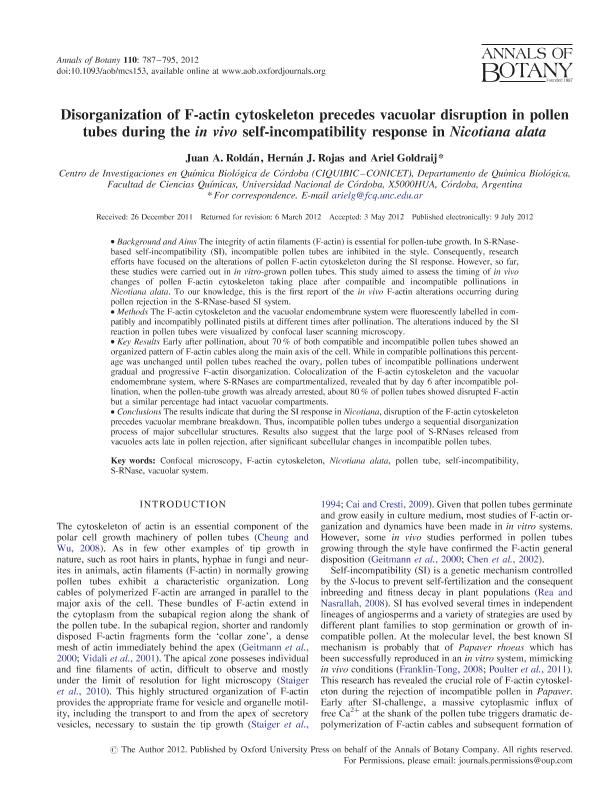Mostrar el registro sencillo del ítem
dc.contributor.author
Roldán, Juan Alfredo

dc.contributor.author
Rojas, Hernan Javier

dc.contributor.author
Goldraij, Ariel

dc.date.available
2024-03-08T15:01:30Z
dc.date.issued
2012-09
dc.identifier.citation
Roldán, Juan Alfredo; Rojas, Hernan Javier; Goldraij, Ariel; Disorganization of F-actin cytoskeleton precedes vacuolar disruption in pollen tubes during the in vivo self-incompatibility response in Nicotiana alata; Oxford University Press; Annals of Botany; 110; 4; 9-2012; 787-795
dc.identifier.issn
0305-7364
dc.identifier.uri
http://hdl.handle.net/11336/229866
dc.description.abstract
Background and Aims The integrity of actin filaments (F-actin) is essential for pollen-tube growth. In S-RNase-based self-incompatibility (SI), incompatible pollen tubes are inhibited in the style. Consequently, research efforts have focused on the alterations of pollen F-actin cytoskeleton during the SI response. However, so far, these studies were carried out in in vitro-grown pollen tubes. This study aimed to assess the timing of in vivo changes of pollen F-actin cytoskeleton taking place after compatible and incompatible pollinations in Nicotiana alata. To our knowledge, this is the first report of the in vivo F-actin alterations occurring during pollen rejection in the S-RNase-based SI system. Methods The F-actin cytoskeleton and the vacuolar endomembrane system were fluorescently labelled in compatibly and incompatibly pollinated pistils at different times after pollination. The alterations induced by the SI reaction in pollen tubes were visualized by confocal laser scanning microscopy. Key Results Early after pollination, about 70 % of both compatible and incompatible pollen tubes showed an organized pattern of F-actin cables along the main axis of the cell. While in compatible pollinations this percentage was unchanged until pollen tubes reached the ovary, pollen tubes of incompatible pollinations underwent gradual and progressive F-actin disorganization. Colocalization of the F-actin cytoskeleton and the vacuolar endomembrane system, where S-RNases are compartmentalized, revealed that by day 6 after incompatible pollination, when the pollen-tube growth was already arrested, about 80 % of pollen tubes showed disrupted F-actin but a similar percentage had intact vacuolar compartments. Conclusions The results indicate that during the SI response in Nicotiana, disruption of the F-actin cytoskeleton precedes vacuolar membrane breakdown. Thus, incompatible pollen tubes undergo a sequential disorganization process of major subcellular structures. Results also suggest that the large pool of S-RNases released from vacuoles acts late in pollen rejection, after significant subcellular changes in incompatible pollen tubes.
dc.format
application/pdf
dc.language.iso
eng
dc.publisher
Oxford University Press

dc.rights
info:eu-repo/semantics/openAccess
dc.rights.uri
https://creativecommons.org/licenses/by-nc-sa/2.5/ar/
dc.subject
Confocal microcopy
dc.subject
F-actin cytoskeleton
dc.subject
Pollen tube
dc.subject
S-RNase
dc.subject
Vacuolar system
dc.subject.classification
Biología Celular, Microbiología

dc.subject.classification
Ciencias Biológicas

dc.subject.classification
CIENCIAS NATURALES Y EXACTAS

dc.subject.classification
Ciencias de las Plantas, Botánica

dc.subject.classification
Ciencias Biológicas

dc.subject.classification
CIENCIAS NATURALES Y EXACTAS

dc.subject.classification
Bioquímica y Biología Molecular

dc.subject.classification
Ciencias Biológicas

dc.subject.classification
CIENCIAS NATURALES Y EXACTAS

dc.title
Disorganization of F-actin cytoskeleton precedes vacuolar disruption in pollen tubes during the in vivo self-incompatibility response in Nicotiana alata
dc.type
info:eu-repo/semantics/article
dc.type
info:ar-repo/semantics/artículo
dc.type
info:eu-repo/semantics/publishedVersion
dc.date.updated
2024-03-05T13:14:14Z
dc.journal.volume
110
dc.journal.number
4
dc.journal.pagination
787-795
dc.journal.pais
Reino Unido

dc.journal.ciudad
Oxford
dc.description.fil
Fil: Roldán, Juan Alfredo. Consejo Nacional de Investigaciones Científicas y Técnicas. Centro Científico Tecnológico Conicet - Córdoba. Centro de Investigaciones en Química Biológica de Córdoba. Universidad Nacional de Córdoba. Facultad de Ciencias Químicas. Centro de Investigaciones en Química Biológica de Córdoba; Argentina. Universidad Nacional de Córdoba. Facultad de Ciencias Químicas. Departamento de Química Biológica; Argentina
dc.description.fil
Fil: Rojas, Hernan Javier. Universidad Nacional de Córdoba. Facultad de Ciencias Químicas. Departamento de Química Biológica; Argentina. Consejo Nacional de Investigaciones Científicas y Técnicas. Centro Científico Tecnológico Conicet - Córdoba. Centro de Investigaciones en Química Biológica de Córdoba. Universidad Nacional de Córdoba. Facultad de Ciencias Químicas. Centro de Investigaciones en Química Biológica de Córdoba; Argentina
dc.description.fil
Fil: Goldraij, Ariel. Universidad Nacional de Córdoba. Facultad de Ciencias Químicas. Departamento de Química Biológica; Argentina. Consejo Nacional de Investigaciones Científicas y Técnicas. Centro Científico Tecnológico Conicet - Córdoba. Centro de Investigaciones en Química Biológica de Córdoba. Universidad Nacional de Córdoba. Facultad de Ciencias Químicas. Centro de Investigaciones en Química Biológica de Córdoba; Argentina
dc.journal.title
Annals of Botany

dc.relation.alternativeid
info:eu-repo/semantics/altIdentifier/url/https://academic.oup.com/aob/article/110/4/787/149992
dc.relation.alternativeid
info:eu-repo/semantics/altIdentifier/doi/http://dx.doi.org/10.1093/aob/mcs153
Archivos asociados
